 |

~ Curious And Unusual ~
- 15 -
the property plaques
a relic of the galaxy of communities
active in Rome over the past centuries
|

|
Besides the flood plaques and the
no dumping notices (described respectively on
page 4 and
page 5 of this section), a further type of inscriptions, very commonly encountered throughout the historical parts of the city, are the ones which in the bygone days stated the ownership of houses. Many of the buildings from which they hang once belonged to the large number of organizations and associations extant in Rome over the past centuries.
| Walking along the streets and the lanes of the central districts, it is impossible not to come across these small and charming documents made of stone, which though remain unseen by most passers-by, partly due to their size, often rather small, but especially because they hang at a higher level than the plaques already dealt with. In particular, they are usually located above the main doorway of houses, or at the level of the first floor and, more seldom, even at upper levels. These plaques are quite heterogeneous in age, as they span over a period ranging from the 16th to the 19th centuries, and as much heterogeneous also in content; actually, besides the written text, many of them feature symbols or images, whose great iconographic variety reflects the large number and diversity of organizations (or societies, as they used to be called) once active in Rome, which already in those days exploited their properties as a form of investment. |
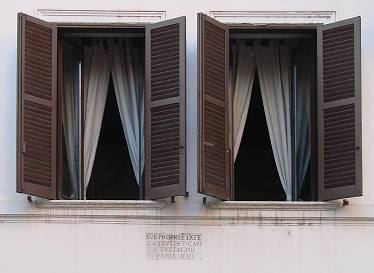
|
In most cases the income was not meant to increase the wealth of the owners, but was rather used for assistance activities and charity purposes.
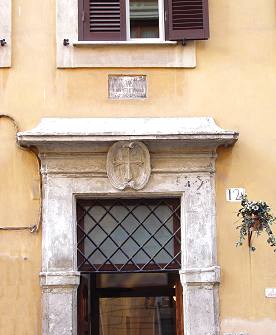 |
|
Many of the original property plaques have gone lost together with the old houses they hung from, or have been removed on the occasion of restorations and refurbishments, and sometimes have even been stolen by collectors; nevertheless, a good number of them (i.e. about five hundred) is still extant, making them the most common type of inscription to be seen in the historical districts. |
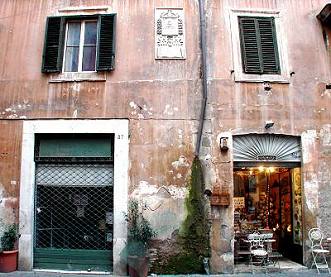 |
This first part describes the ones concerning houses that belonged to religious bodies, while the second part deals with the ones belonging to foreign communities resident in Rome and to workers' guilds. |
Those who wish to locate the plaques shown in these pictures can run the mouse cursor over the images, to read their precise address; in order to take a good look at the smaller ones, the ones hanging at higher levels and the ones no longer in good condition, it is advisable to carry pocket binoculars.
| It should be said that among the surviving property plaques, many of them refer to properties belonging to private individuals and their own families. The typology of these ones is rather plain and monotonous: they mention essentially the owner's name and surname, often together with expressions such as libera da canone ("free from fee") or similar ones, stating the fact that the house was not subject to the paiment of any rent. A large majority of them is written in Italian, only the older ones being written in Latin (samples below). |
|
sample property plaques of private individuals
|
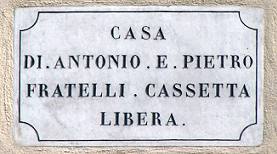 |
Some mention also the year in which the house came into the owner's possession, the floor (if the property was limited to one or more flats), or a progressive number (if the owner had more than one house) and, possibly, the right for descendants to inherit the property. |
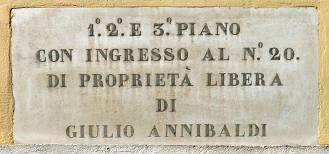 |
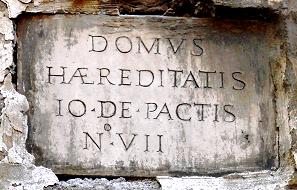
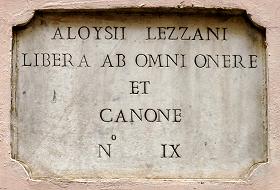
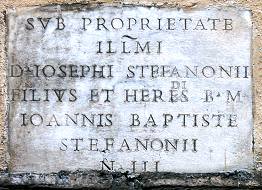
In either case, the very simple look of these plaques can be told by the samples shown above.
| The most interesting plaques, though, are not the ones of private owners, but rather those referring to various bodies such as churches, convents, congregations, hospices, hospitals, conservatories (i.e. houses for poor or orphan girls, run by nuns), colleges, workers' guilds, foreign communities in Rome. Since all of them are older than the former plaques, they are written in Latin. |
|

plaque of the Confraternity of the Holy Annunciation, which in the left panel features an Annunciation scene |
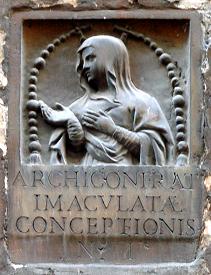
plaque of the Archconfraternity
of the Immaculate Conception
|
In almost all cases, in the lower part of these plaques a roman numeral is featured, indicating in which order the property was listed in the owner's register. Although very often such number is small, sometimes numbers above 100 are found (and in one case even above 300!). This clearly shows how some bodies or associations could rely on rather rich property assets. Sometimes the original number was obliterated (as the sample on the right), and then a different one was added, due to alterations of the property list that occurred when a house was sold or handed over to new owners.
|
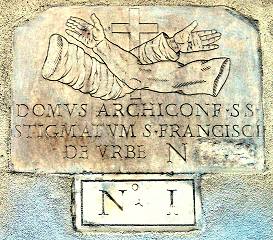
plaque of the Archconfraternity of
the Holy Stigmata of St.Francis;
note the original number chiselled off |
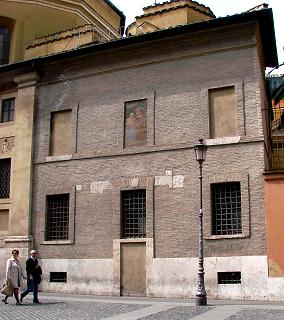
↑ on this old house a 1614 fresco states that
the Confraternity of the Horse Groomers
was the owner (the text is shown in detail) →
|
|
Despite the typical shape of these documents was a stone plaque hanging from the house, in a few cases the notice was painted, featuring a rather elaborate pattern too: undoubtly, this indicates a decorative purpose for the building, besides the legal function. The most evident examples are the ones found on the properties of the Spanish community in Rome, one of which is shown on the right, but they are not the only ones. |
|
 |
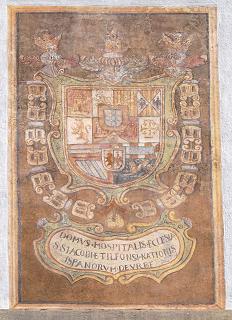
↑ fresco indicating that the house
belonged to the hospital of the Spanish
church of the Saints James and Alfonso |
Finally, examining the topographic distribution of the property plaques, it is interesting to observe that th houses belonging to churches, hospitals, associations, etc. were mostly located in the streets nearby the main seat of the latter, but in quite a few cases, especially when the owner was important, its properties could be found also in other parts of the city, sometimes very far, as well.
part I
plaques referring to religious bodies
The largest number of property plaques concerns houses that belonged to religious bodies. They included churches and basilicas (important ones too), abbeys, convents and monasteries, confraternities and archconfraternities.
With the exception of the ones that feature only two keys and the tiara embossed, i.e. the emblem of the Chapter of St.Peter's in the Vatican, all the others mention the church they referred to with a more or less explicit text, sometimes accompanied by symbols or images in relation with the relevant saint.
plaques on houses belonged to the Chapter of St.Laurence in Damaso and →
to St.Laurence in Panisperna, both featuring the grill, symbol of the saint
|
|
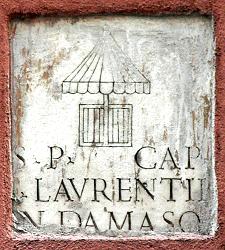 |
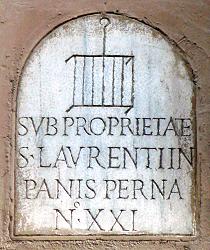 |
plaques of the church of St.Mary of Soul (S.Maria dell'Anima) and the basilicas
of St.Mary in Trastevere, St.Peter in the Vatican and St.John in the Lateran |
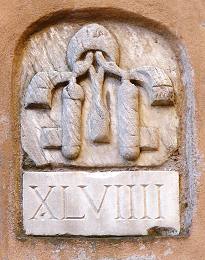 |
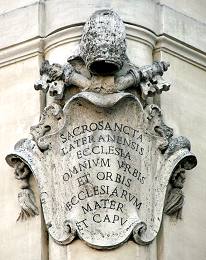 |
The ones referring to the several houses owned by Santa Maria di Monserrato (St.Mary of Montserrat), a church of the Spanish community in Rome, located in the Rione VII, Regola, are rather interesting from an iconographic point of view. The church was built around 1495 by the Aragonese and Catalan communities over the ruins of an older church or chapel with an annexed hospital, St.Nicholas of the Catalans, founded during the first half of the 1300s by a noble lady from Barcelona. Its title comes after that of a famous sanctuary located in the surroundings of the aforesaid city, named after the Virgin of Montserrat, on the hill that bears the same name. Mont serrat in Catalan means literally "sawed hill", therefore the property plaques feature a curious image of the Virgin and Child, in which the latter is cutting the hill with a carpenter's saw.
In 1610, the remains of two Spanish popes, Callistus III and Alexander VI, from the Borgia family, were moved into Santa Maria di Monserrato's church; they had been initially buried in the old St.Peter's in the Vatican, in the chapel called Santa Maria della Febbre (St.Mary of Fever), later taken down during the making of the newer basilica. But also in the second church, their remains were actually buried only in 1889. |
|
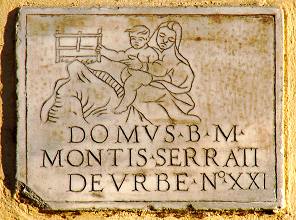
plaque of St.Mary of Montserrat
|
|
| 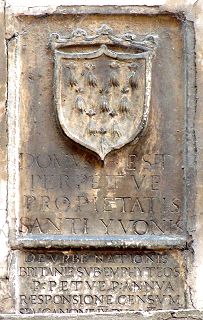
the text below the shield reads:
"THE BUILDING IS
A PROPERTY OF ST. YVES
FOR AN UNLIMITED TIME" |
In the Rione IV, Campo Marzio, once stood the church of Sant'Ivo dei Bretoni (St.Yves of the Bretons), built by the mid 1400s in replacement of an older one (12th century) whose title was Sant'Andrea de Marmorariis or de Mortarariis. Callistus III had granted the new church to the Bretons, who by that time formed a country independent from the kingdom of France. Also this church, as others (see further), had an annexed hospice and a hospital, founded in 1511 by Julius II for the benefit of the pilgrims from Brittany. Around 1575, though, the management of the hospital was given by Gregory XIII to the French nation, thus becoming dipendent from the nearby church of St.Louis (see further, hospital of St.Lewis). Sant'Ivo's church was taken down in the second half of the 1800s and in 1878 it was rebuilt on the opposite side of vicolo della Campana, where it can be still found today. The only surviving property plaque stating Sant'Ivo dei Bretoni's ownership (on the left) features the coat of arms of Brittany, with ten hermins.
The text in the lower panel, instead, mentions a type of contract that during the Middle Ages was rather common, remaining in practice also for several centuries later, called emphyteusis. It consisted in leasing a property (in this case, the house) for an unlimited time, in any case no less than ten years, on the payment of an annual fee. By effect of emphyteusis, the signer of the contract could enjoy the property as he wished, almost as if it belonged to him. By paying an agreed number of annual dues in one time, he could redeem the property and become the new actual owner, with full legal rights. Conversely, if the annual fee was not payed, the property would return into the possession of the original owner. |
|
Also the main chapels inside the large basilicas, belonging to noble families, were sometimes property owners.
| An example is the plaque shown below, unfortunately rather washed off, referring to one of the houses under the ownership of the Giulia Chapel, in St.Peter's in the Vatican (whose emblem is shown in the detail on the right). Also in this case there is a reference to ancient tenancy law, as laudemii and quindennii are mentioned. |
|
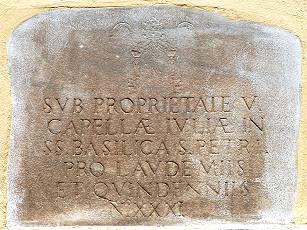 |
| The laudemium was a fee once payed by vassals any time the lord of a feud they were bound to changed, as a sign of approval (the term likely comes from the Latin laudare, i.e. "to approve, praise"); in time, this name was transferred to a tax due any time a long-term contract was renewed (for instance, the aforesaid emphyteusis contract). The quindennium, instead, consisted in 10% of the property's value, due by the tenant to the owner every fifteen years (quindecim in Latin, whence the name).
|
|
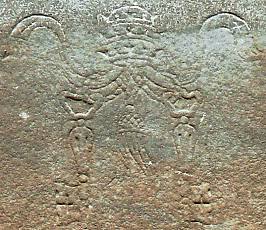 |
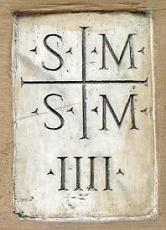 |
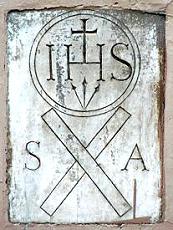 |
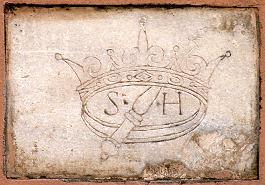
(from the left) plaques of Santa Maria
sopra Minerva, Sant'Andrea della Valle and
Sant'Onofrio (Sanctus Honuphrius in Latin) |
|
|
There are plaques whose text is shortened to the limit, probably also for economic reasons (stone masons were payed by the number of letters they engraved!), at the point that they can be barely understood, except by those who know by heart the names of the nearby churches: the samples shown on the right are entirely abbreviated, and refer to churches located in the near surroundings. |
The ones referring to houses owned by abbeys, convents and monasteries are, in a large majority of cases, small plaques, very sobre in shape, with text alone or, at most, small symbols, as the ones shown below.
property plaques of the abbey of St.Peter in Chains, and of the monasteries of St.Praxedes, St.Sylvester in Capite and St.Catherine of Siena
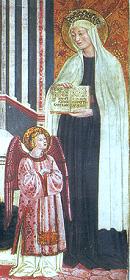 |
The plaque in vicolo Sugarelli, by via Giulia, is more eloquent: it gives the ownership of the building to the convent of Tor de' Specchi, the seat of the Oblates of Santa Francesca Romana, located by the base of the Capitolium Hill. This institution, srill extant today, differed from other similar ones of those days in the fact of being the Oblates the first example of female lay congregation, although they dwelt inside the convent: such right had been granted in 1433 by pope Eugene IV to the popular Roman saint (whose name was Francesca Ponziani) and to her nine sisters, co-founders of this Order. The Oblates sought inspiration from the Benedictine Order, but were not obliged to follow its rule, nor to pronounce monastic votes, nor to live secluded, as any other female religious community had to do in those days. They did not depend from any clergy hierarchy and were free to elect their president. Their mission, historically born as a form of assistance to the poor and the sick, is today mainly oriented towards the reaching of the Catholic precepts.
The property plaque features St.Francesca Romana with her guardian angel, in the same way she was portrayed by Antoniazzo Romano in his famous fresco paintings of the late 1400s, still extant in the chambers of the convent (on the left; for further details see the section Language and Poetry). |
|
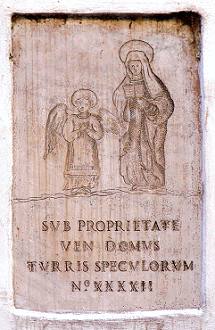 |
If the previous case represents an early exception in the world of female congregations, in the past, the organizations called confraternities, born between the late Middle Ages and the early Renaissance, strictly for male members, were so common that still today the plaques referring to their property assets represent the overwhelming majority among the extant ones.
| Confraternities were heavily inspired by religious principles, as can be told by their names, but those wo became members were lay volunteers, called brethren; their statute was to be approved by the pope and had to include one or more deeds to pursue. Their seat was a church or an oratory, which for larger confraternities (i.e. archconfraternities) was built on purpose for them. In some cases, the same confraternity could have more branches seated in different churches (samples on the right); among the benefits of such practice was the need of a meeting place not too large in size, and the opportunity for the brethren to attend without having to move very far from their houses. |
|
property plaques of the Archcongregation of the Holy Sacrament, by
"the basilica of the Prince of Apostles" (i.e. St.Peter's) and St.Laurence in Damaso
|
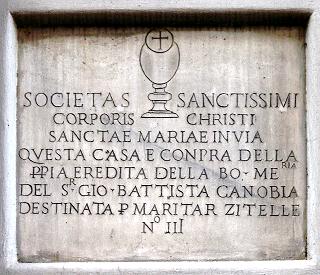 |
The members wore a sort of uniform, consisting of a cloak and often also a hood of a specific colour. Furthermore, every confraternity had its own emblem o r seal, which acted very much like a heraldic coat of arms and is often featured in the property plaques. These congregations owned houses and buildings, partly bequested by rich faithful and elder brethren (as shown by the specimens on the left and below), or purchased with the funds of the same congregation as a form of investment: these buildings were rented and the income was then used for performing the confraternity's deeds.
← ↓ (left and below) plaques of houses bequested by Giovanni Battista Canobia
to the Confraternity of the Holy Body of Christ, whose seat was by the church of
Santa Maria in Via, to provide unmarried girls with a dowry |
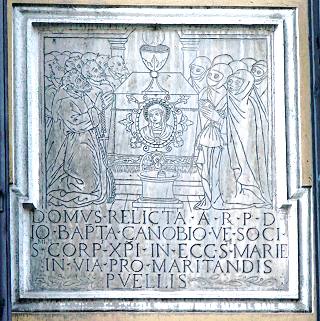
| The most common charity deeds and missions were to give assistance to the sick, to comfort prisoners in jail, to bury the dead and to provide poor unmarried girls (or 'spinsters' as they used to be called) with a dowry, as mentioned in the plaques on the left; the curious detail on the right features such 'spinsters', who attended the special celebration during which a bag of money was given to them completely covered in a white veil, except the eyes.
|
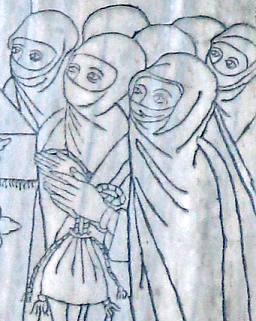
|
It is worth mentioning the most important associations, many of which had their seat in the streets surrounding via Giulia, the heart of Renaissance Rome.
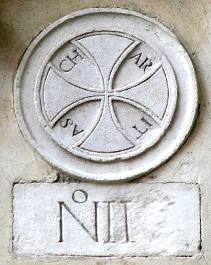 |
Archconfraternity of Charity (Arciconfraternita della Carità)
This confraternity is still extant. After its foundation in 1518 by cardinal Giulio de' Medici (the future pope Clement VII), it was approved in the following year by his cousin Giovanni, who then became pope Leo X. The Confraternity had its seat by the church of Sant'Andrea de Unda, in Regola district; it was moved in 1536 to St.Jerome of Charity, a church built for this purpose in 1524, with an annexed refectory, a dormitory, a hospice, and even a library. The Confraternity's mission was to take care of several charity deeds; among its actual projects were the making and the management of the Convent of the Converted nuns (who were formerly prostitutes) and the management of the New Prison, whose making had been sponsored by Innocent X around 1650 (see the relevant page in the Rioni section). During the second half of the 1500s, among the Confraternity's contributors was St. Philip Neri, who also lived in the complex by St.Jerome; but most of the members of the congregation came from aristocracy and from the high clergy, at the point that in 1647 che church of the Confraternity was entirely rebuilt thanks to a large sum of money bequested by one of the brethren. Among the privileges of the congregation was the right to free one prisoner sentenced to death each year, provided the crime had not been too serious, such as premeditated murder, poisoning, but also document or papal money forgery, and even lese majesty! The emblem found of the property plaques consists od a Greek cross with curved edges, among whose arms the word CH·AR·IT·AS is inscribed in clusters of two letters. |
|
Archconfraternity of the Banner (Arciconfraternita del Gonfalone)
The name Banner first appeared by the mid 14th century, when four small congregations united into one organization; the larger of the four was known as the Recommended of St.Mary the Virgin, and it had been founded in 1246, with its seat by the basilica of St. Mary the Major. The name taken by the newborn organization was the Recommended of the Banner. Some believe that this may have sprung from a historical anectode: around 1350, the nobleman Luca Savelli, who belonged to the Welf party, had seized the temporal power and had chased away from Rome the papal vicar (who in those days was the highest papal authority in Rome, having the papal seat been moved to Avignon, in France). But the people, who had united under the banner of the Recommended of St.Mary the Virgin, rebelled against Savelli's authority. The latter ended up handing down the power to a different ruler, chosen by the same brethren of the congregation. More likely, the name may come from the brethren's custom to carry the papal banner during processions, to remark the pope's authority over Rome, despite in those years the popes officially resided in France. |
|
|
During the second half of the 1400s, the former seat by St.Mary the Major's basilica was moved to Old St.Lucy's, a church located on the eastern bank of the Tiber, in Regola district. Here the Reccomended merged with a further local congregation, and in 1486 they were granted the papal approval by Innocent VIII, thus becoming the Confraternity of the Banner. In the same year, due to the frequent river floods, their seat was once again moved to New St.Lucy's (on the Parioli Hills, north of the city); they kept merging with other congregations, so that their importance grew more and more. By the turn of the 1500s, the Confraternity became renowned for a very particular deed: to perfom religious plays, particularly those concerning Christ's passion, held on Good Friday. The chosen site was the Colosseum, where crowds of people came to enjoy the event. But since the public threw stones at the actors who played Christ's torturers (at the point of threatening their personal safety), Paul III banned this tradition. For a few more years the plays were held in other locations, with less audience participation, and finally they ceased. Meanwhile, in 1547 the church of Old St.Lucy, which had turned in bad condition, was completely refurbished into the Oratory of the Banner; so the Confraternity moved back to its old seat by the river. |
|
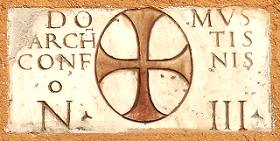
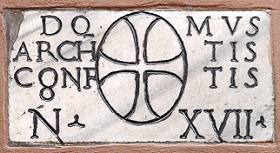
|
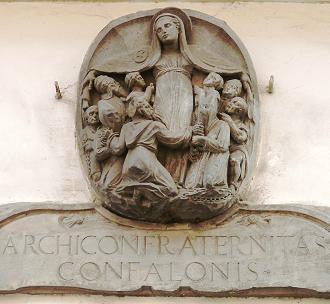 |
On the occasion of the Jubilee Year in 1550, Julius III granted the congregation the privilege to free one prisoner sentenced to death each year. In 1579, Gregory XIII, after having raised its degree to Archconfraternity, increased such right to two prisoners per year, and in 1581 entrusted the Confraternity with a new important mission: to free the Christians kept in slavery in the Ottoman lands (as remarked by the relief hanging above the doorway of the oratory, shown on the left, featuring the Virgin Mary who protects slaves and the members of the congregation under her veil). Over about two centuries, most of the funds of the Confraternity of the Banner were used for redeeming thousands of slaves. The decline of the congregation started with the French occupation of Rome, between the 18th and 19th century. Once the papal authority had been restored, Pius VII entrusted the Archconfraternity with the management of a small hospice for former female convicts, by St.Mary in Trastevere's church. Then, after the fall of the Papal State, throughout the 20th century the congregation slowly came to an end. As of 1968, the Oratory of the Banner has become the seat of Rome's Polyphonic Choir. Its seal, which can be found on a large number of plaques in the streets surrounding the Oratory, features a Greek cross, rather similar to the one of the Archconfraternity of Charity, previously described, inscribed in a circle without any letter. |
Archconfraternity of the Holy Saviour by the Sancta Sanctorum (Arciconfraternita del Santissimo Salvatore ad Sancta Sanctorum)
One of the oldest congregations was named after the Byzantine icon of the Saviour (below, right) kept by the Holy Steps, or Sancta Sanctorum. |
|
It was founded in 1286, and its mission was to provide assistance to the many pilgrims who visited this holy site, and to comfort the sick. Once having grown powerful, between the 14th and 15th centuries, with an important property asset scattered over different districts, the congregation founded two hospitals, the one entitled to the Holy Saviour by the Sancta Sanctorum (whom the plaques refer to, also known as Sant'Angelo Hospital) and that of St.James by the Colosseum.
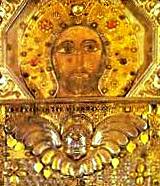 |
|
Furthermore, the Archconfraternity also managed a number of Colleges, among whom Capranica, Nardini, Crivelli and Ghisleri. Its brethren were known as Porters, or Recommended of the Holy Saviour. The congregation's importance declined only during the 1800s, until it finally came to an end. |
|
|
|
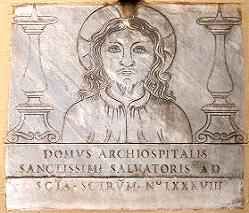
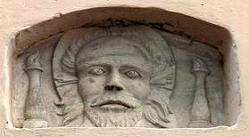
plaques of the Arch-hospital of the
Holy Saviour by the Sancta Sanctorum,
of different types and ages |
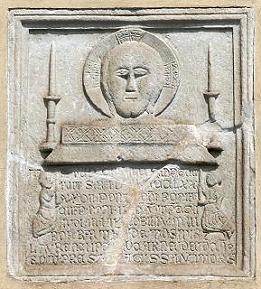
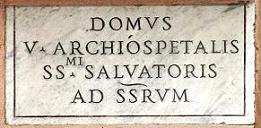
|
|
| The emblem of the Archconfraternity is featured on almost every surviving plaque: an image of Christ between two candlesticks, either engraved or embossed, with various typologies, which can be partly explained with the different age of these plaques. |
|
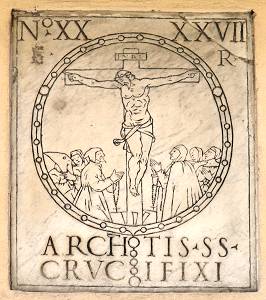
plaque of the Archconfraternity, with
several people praying below the cross,
among whom the hooded brethren |
Archconfraternity of the Holy Crucifix (Arciconfraternita del Santissimo Crocifisso)
In the early 1500s a fire burned down the church of St.Marcel in via Lata (today's via del Corso); only a 15th century crucifix was spared, whose votive lamp was miraculously found still lit. A small group of faithful began to gather every friday evening for lighting candles to this image, until the number of volunteers grew up to the point of founding a congregation, in 1519. Three years later Rome was stricken by a serious plague that caused many victims. The people thought of carrying in procession the miraculous crucifix, but the church authorities forbade this initiative, fearing that the disease would spread even more. The population disregarded the prohibition, and the procession lasted continuously for no less than sixteen days, because wherever the image was carried, the people used all sorts of tricks for delaying its departure. In the end, when it was taken back to St.Marcel, the plague has ceased.
Plaques exist in two iconographic variants. |
|
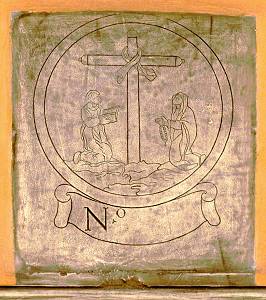
a more simple variant: the crucifix
is empty and wrapped with a scarf,
with only two people praying below |
Archconfraternity of the Pity for Convicts (Arciconfraternita della Pietà ai Carcerati)
This congregation, still extant, was founded in 1575 by the initiative of a French Jesuit, Jean Tallier, who was active in Rome as a confessor for the convicts of the jails used in those days, i.e. Tor di Nona and Corte Savella (further details can be found in Rione V, Ponte and Rione VII, Regola). Initially limited to a small numer of volunteers, it was backed by pope Gregory XIII, who raised its degree to Archconfraternity. The following pope, Sixtus V, granted the congregation the right to free one prisoner sentenced to death each year. The seat of the congregation was the church of Saints Cosmas and Damian de Pinea, in the heart of Rione IX, Pigna, but already in 1584 it was moved to the church standing in front, dedicated to Saints Eleuterio and Genesio; the congregation had the latter rebuilt in 1624, changing its title into St.John of Pigna. |
|
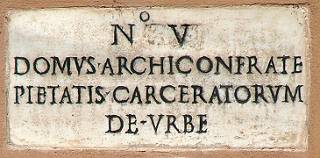
the original number on this simple plaque
was clearly chiselled off and changed into V |
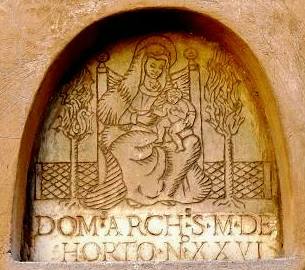 |
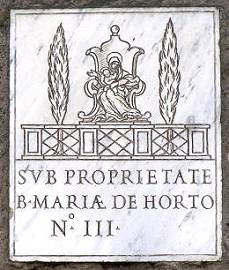 |
|
Archconfraternity of St.Mary of the Orchard (Arciconfraternita di Santa Maria dell'Orto)
By the end of the 15th century, the southernmost part of Trastevere district was uninhabited and covered with cultivated fields (orchards). One day, an incurable sick man was passing by one of these fields, when he saw an image of the virgin Mary hanging from an old wall. He made a vow to light a perpetual lamp there, had the image cured him from his illness, and this eventually happened. Also other people started gathering to worship this image, so shortly the Confraternity was founded; it was approved in 1492 by Alexander VI. Next to the image an oratory was built, later on replaced by the present church, which was finished in 1567. |
|
| By the same time, also a small annexed hospital was founded. In 1588, Sixtus V raised the degree of the congregation to Archconfraternity. Its emblem, found on the many surviving plaques, the Virgin Mary with the Child is sitting on a throne with a tall back, flanked by two cypress trees, in the middle of a garden surrounded by a fence, according to the medieval iconography of the hortus conclusus (enclosed garden), symbol of virginity (but with a likely reference to the orchard, as well). Also several workers' guilds aggregated to this Archconfraternity (see part II for details). |
|
Archconfraternity of St.Mary by the Porch of Consolation and Mercy (Arciconfraternita di Santa Maria in Portico della Consolazione e delle Grazie)
It was founded in 1506 to manage a hospital built behind the church of St.Mary of Consolation, after which the congregation was named, located at the base of the Tarpeian Rock and adjacent to the Roman Forum. The church had stood there since 1470, although it was later rebuilt into its present shape by the end of the following century. The title Consolation originated when by the end of the 1300s, a nobleman who had been sentenced to death, before climbing on the scaffold (which in those days was set up there), left a sum of money for the making of an image of the Virgin Mary, to comfort future prisoners to be sentenced. The picture was initially hung below a porch that belonged to the Mattei family. One day, a mother whose son had been unjustly sentenced to death, pleaded with this image, being reassured by the Virgin Mary that her son would be spared. Such miracle was worth the image the name Virgin Mary of Mercy; later on it was moved inside the church.
The Consolation Hospital incorporated a second smaller church, older than the aforesaid one; some time later, it was given the same title St.Mary of Mercy and was refurbished; then, during the 1800s, it was turned into a ward of the same hospital. |
|
| 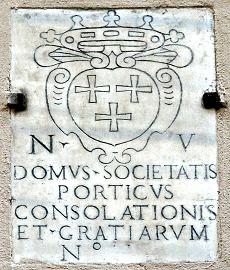 |
| The church of Santa Maria della Consolazione was managed by a company of gentlemen belonging to several important families of the Roman aristocracy, among whom Frangipane, Savelli, Mattei, and Colonna. For this reason, besides the Confraternity in charge for the Consolation hospital, by tradition also many dames from the aforesaid families used to serve as volunteer nurses. Beyond the hospital was an annexed cemetery, which once stretched towards the Roman Forum up to the Basilica Iulia; it vanished following the archaeological excavations carried out in this area. Today the wards of the former hospital act as one of Rome's municipality's bureaus. |
|
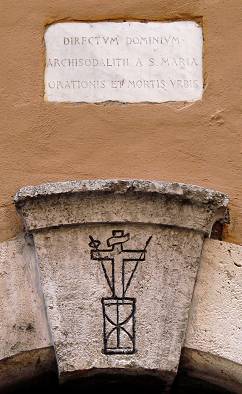 |
|
Archconfraternity of St.Mary of Prayer and Death (Arciconfraternita di Santa Maria dell'Orazione e Morte)
It was founded in 1538, due to the great number of corpses of poor people left unburied in the streets, as well as in the countryside. The brethren took care of going around the city and collect them, to give them a burial place in the cemetery arranged in the basement of the church that bears the same title as the congregation, located in via Giulia, just behind Farnese Palace (see Rione VII, Regola). In 1560 Pius IV raised the congregation to the degree of archconfraternity. Its seal features an hourglass, a reminder of the transience of time, topped by a cross with the symbols of Christ's passion (the sponge and the spear). |
|
Congregation of the Holy Wounds (Congregazione delle Santissime Piaghe)
This was a minor congregation, whose mission was to help needy women and sick priests. It was founded in 1617 by a follower of St.Philip Neri, the Florentine Rutilio Brandi (who was a glove-maker). Its seat was an oratory dedicated to the same saint amd located in via Giulia, which the people used to call 'the Small St.Philip' because of its tiny size. The only extant property plaque, hanging very close to the oratory, features the motto of the congregation, which reads in Latin "the wound is healed by the wounds", and once again the symbols of Christ's passion, in the shape of the spear, the nails and the crown of thorns. |
go to part II
|
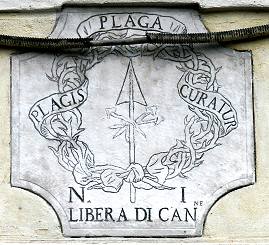 |


